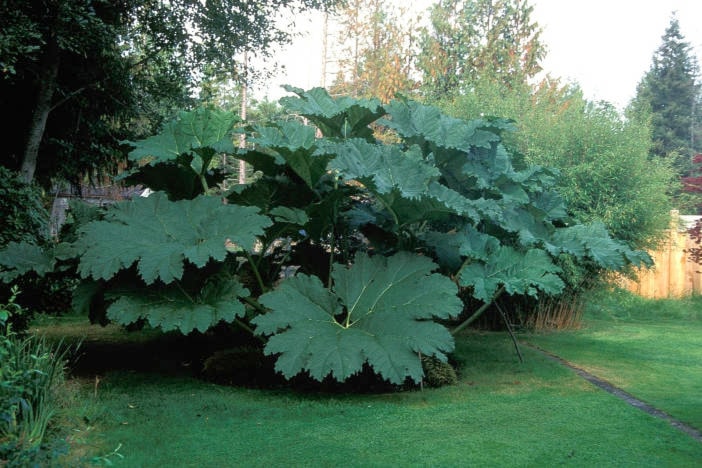‘What a Monster’ is what naive gardeners might say, with gleeful enthusiasm, while reaching for their wallets to pay for this 15 foot tall flowering plant with the 5 foot wide serrated leaves.
However, its victims might say the phrase in rueful anguished voices, as invadingspecies.com says they risk severe dermatitis, and could continue to suffer from ping pong ball sized blisters for the next 10 years, every time their affected skin is exposed to sunlight. It can be a painful experience if skin contacts the poisonous sap of Giant Hogweed, then spends time in sunshine, before it is completely washed off.
No, it is not in our region, yet.
In B.C., only the southwest coast and its local islands are cursed by the presence of this huge satanic herb. So, let us focus on saner Grow-me-instead-choices like Blue Elderberry, Ligularia, Rodgersia, Shieldleaf Rodgersia, and, perhaps, Wild Celery.
Blue Elderberry was mentioned a month ago in my article on English Holly. Nativefoodsnursery.com tells us that Elderberries are used by makers of wine, jam, syrup and pies.
It’s flower clusters can be dipped in batter and fried or added to pancakes and fritters, and its steeped flower petals make a tasty fragrant tea. Blue Elderberry is low maintenance for life and your bird buddies will be happy to harvest any fruit you overlook.
Ligularia aka ‘The Rocket’ finegardening.com maintains it is almost indestructible if planted in a damp shady place, and that in midsummer its daisy-like flowers bloom progressively from the bottom to the top of the stem like a rocket’s tail rising into the sky, provided you don’t let the soil dry out.
Rodgersia, according to finegardening.com “creates tropical drama, with its large, toothed leaves and ivory-green, foot-long flowers,” when planted in moist soil. Shieldleaf Rodgersia is a big leaved umbrella plant variety with round, three-foot diameter, pale green, slightly fuzzy, toothed leaves on three-foot stems that could likely be used as an umbrella.
To grow well, this plant, bearing fluffy white flowers on four- to five-foot stems, needs moist soil, partial shade and protection from the wind. Wild Celery is in a problematic, edible, medicinal, native group of plants that includes Cow Parsnip- which can be toxic to some people.
The Wild Celery family also resembles poisonous native plants, like water hemlock and poison-hemlock, so beware!
Weed Warrior Frank
